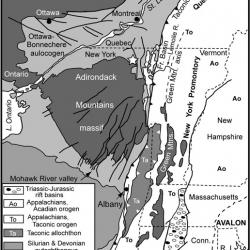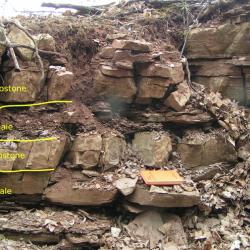Altona Formation
Not everything is known about New York State geology after two hundred yeard of study. The oldest rocks in non-Appalachian New York have traditionally been thought to be sandstones of the Potsdam Formation. The Potsdam sandstomes generally rest directly at a nonconformity with the much older, highly metamorphosed basement of the Adirondack Mountains dome.
The well sorted, coarse sandstones of the upper Potsdam (Keesville Member) have upper Middle to lower Upper Cambrian trilobites (ca. 495--492 million tears ago [m.y.], and are well dated. However, an older feldspathic-rich sandstone (Ausable Member) forms the lower part of the Potsdam in parts of the Lake Champlain valley and thickens (to 1,700 feet) to the northeast borderland of the Adirondacks and into southern Quebec. A lack of any fossils in the Ausable Member led to many speculations of its age--with a common belief that it ranges down into the upper Precambrian (perhaps to 570+ m.y.).
The latter speculation ended in 2006 with the discovery of a new stratigraphic unit below the Potsdam Formation that rests unconformably on the Grenville rocks. This new formation was long overlooked because it is not resistant to erosion and forms a lowland between the northern Grenville hills and the first craggy outcrop of the Ausable Member. However, its outcrop belt is distinct in that the formation weathers into red soils.
The new formation, called the Altona Formation, conformably underlies the Ausable Member and gives a maximum age for the latter. The oldest rocks of the Altona have late Early Cambrian trilobites (Olenellus) along the Old Military Turnpike west of Plattsburgh, and the youngest rocks produce middle Middle Cambrian trilobites (Ehmaniella) in low outcrops along West Chazy River just west of Atwood Road. These youngest rocks include red shales and thick dolostones and look nothing like anything in the Potsdam. An estimated age for the Ausable Formation would be 510--495 m.y.
The deposition of the Altona Formation is related to marine inclursion related to the down-dropping of the Ottawa-Bonnechere graben, the failed arm of a terminal Precambrian through earliest Cambrian graben system produced with break-up of the Pangaea supercontinent and formation of the Iapetua Ocean east of Laurentian (ancestral North America).




